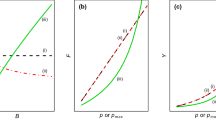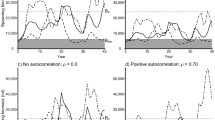Abstract
One important component of almost all theoretical models in fishery is a fish transfer function. However, most of the current fish transfer functions have significant shortcomings. This paper contributes to the literature on fishery management by (1) showing some of shortcomings of commonly used fish transfer functions and proposing a new fish transfer function that is more appropriate to model net amount of fish transfer from one marine area to another; and (2) applying the proposed transfer function in an optimal harvest problem to assess the economic payoff from a switching reserve versus a fixed marine reserve. The findings indicate that a switching marine reserve appears to provide fishers with higher economic benefits than a fixed marine reserve. The payoff gain from a switching reserve appears to increase when the fish move less because of bio-ecological and territorial factors that impede the fish dispersal between marine areas.

Similar content being viewed by others
References
Beverton RJH, Holt SJ (1957) On the dynamics of exploited fish populations. Fishery investigations, Ser 2, vol 19. UK Ministry of Agriculture, Fisheries and Food, London, 533 pp
Bhat M (2003) Application of non-market valuation to the Florida keys marine reserve management. J Environ Manage 67:315–325
Gerber L, Botsford L, Hastings A, Possingham H, Gaines S, Palumbi S, Andelman S (2003) Population models for marine reserve design: a retrospective and prospective synthesis. Ecol Appl 13:S47–S64
Gordon H (1954) The economic theory of a common-property resource: the fishery. J Polit Econ 62:124–142
Grafton Q, Kompas T, Ha PV (2006) The economic payoffs from marine reserves: resource rents in a stochastic environment. Econ Rec 82:469–480
Hasting A (1982) Dynamics of a single species in a spatially varying habitat: the stabilizing role of high dispersal rates. J Math Biol 16:49–55
Hasting A (1983) Can spatial variation alone lead to selection for dispersal. Theor Pop Biol 24:244–251
Hastings A, Botsford L (2003) Comparing designs of marine reserves for fisheries and biodiversity. Ecol Appl 13:S65–S70
Hilborn R, Walters C (1992) Quantitative fisheries stock assessment: choice, dynamics and uncertainty. Kluwer, London
Holland D, Brazee R (1996) Marine reserves for fisheries management. Marine Resour Econ 11:157–171
Holt R (1985) Population dynamics in two-patch environments: some anomalous consequences of an optimal habitat distribution. Theor Pop Biol 28:181–208
Kramer D, Chapman M (1999) Implications of fish home range size and relocation for marine reserve function. Environ Biol Fish 55:65–79
Levin S (1976) Population dynamic models in heterogenous environments. Annu Rev Ecol Syst 7:287–310
MacCall A (1990) Dynamic geography of marine fish populations. University of Washington Press, Seattle
Miranda M, Fackler P (2002) Applied computational economics and finance. MIT Press, Cambridge
Polachek T (1990) Year around closed areas as a management tool. Natural Res Model 4:327–354
Roberts C, Bohnsack J, Gell F, Hawkins J, Goodridge R (2001) Effects of marine reserves on adjacent fisheries. Science 294:1920–1923
Sanchiroco J (2004) Designing a cost-effective marine reserve network: a bioeconomic metapopulation analysis. Marine Resource Econ 19:46–63
Sanchiroco J, Wilen J (1999) Bioeconomics of spatial exploitation in a patchy environment. J Environ Econ Manage 37:129–151
Sanchiroco J, Wilen J (2001) A bioeconomic model of marine reserve creation. J Environ Econ Manage 42:257–276
Sanchiroco J, Wilen J (2002) The impacts of marine reserves on limited-entry fisheries. Natural Res Model 15:340–400
Scott A (1955) The fishery: the objectives of sole ownership. J Political Econ 63:116–124
Smith M, Wilen J (2003) Economic impacts of marine reserves: the importance of spatial behaviour. J Environ Econ Manage 46:183–206
Vance R (1984) The effects of dispersal on population stability in one-species, discrete space population growth models. Am Nat 123:230–254
Worm B et al (2009) Rebuilding global fisheries. Science 325:578–585
Author information
Authors and Affiliations
Corresponding author
Rights and permissions
About this article
Cite this article
Linh-Son, N., Dieu-Hang, T. Shortcomings of current fish transfer functions and a proposal for a new transfer function. Rev Fish Biol Fisheries 22, 933–942 (2012). https://doi.org/10.1007/s11160-012-9278-2
Received:
Accepted:
Published:
Issue Date:
DOI: https://doi.org/10.1007/s11160-012-9278-2




